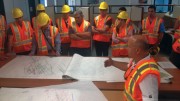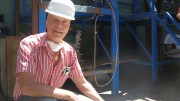YAMOUSSOUKRO, CÔTE D’IVOIRE — It’s easy to stay awake while travelling during the early morning hours in Côte d’Ivoire’s remote political city, Yamoussoukro. Formerly a small agricultural village, the capital is intriguingly desolate, with empty six-lane highways that appear to lead to nowhere.
But off the main road network, 80 km south, there’s activity breaking the stillness at Endeavour Mining’s (TSX: EDV; US-OTC: EDVMF) Agbaou gold mine. The company has reported the operation is exceeding its expectations, and The Northern Miner has travelled the 12,000 km from Vancouver to investigate why.
“There were a lot of moving parts last year,” Doug Reddy, senior vice-president of business development, says while our van navigates past a few rusty bicycles piloted by onlookers eager to catch a glance. “A lot of improvements have been made, so it’s been nice to see the numbers reflect this.”
He distributes the company’s first-quarter results between the passengers as reading material for the two-hour journey. The intermediate gold miner reported producing 123,744 oz. gold, up 17% compared with the 105,912 oz. gold in the first quarter of 2014.
The gold came from its four operating mines across West Africa: Youda in Burkina Faso; Agbaou in Côte d’Ivoire; Nzema in Ghana; and Tabakoto in Mali.
Endeavour had an all-in sustaining cost (AISC) of US$946 per oz. gold, generated US$13-million in after-tax net profit and raised its earnings before interest, taxes, depreciation and amortization to US$44.9 million.
Results from the previous comparable quarter include US$1,059 per oz. gold, US$5 million and US$36.1 million.
Conversation about the project’s economics is suddenly interrupted as the van crests the hill and the sight of the world’s largest basilica, Our Lady of Peace, is seen towering 200 metres into the morning clouds.
The US$300 million, St. Peter’s in Rome lookalike is a legacy of former president, Felix Houphouet-Boigny — a man who saw the rise of the cocoa industry as an opportunity to lavish much of the revenue on monuments, including a presidential palace surrounded by a crocodile-filled lake.
“There’s definitely been an interesting history here,” Reddy says, pointing towards the window. “There was a whole period of time where the country focused solely on agriculture, but all that is changing now. The new government wants to diversify its interests and sees foreign investment as the way to go.”
According to Reddy, Agbaou mine was the “testing ground” for the country’s new mining code, which was introduced in March last year.
He says the legislation has made Côte d’Ivoire more competitive with Mali and Burkina Faso, despite already having advantages over its neighbours.
“There’s good infrastructure, cheap power and plenty of water that really gives Côte d’Ivoire a leg up on the other countries,” he says, with mention of the rolling blackouts in Ghana due to a two-year drought that is drying up the country’s main hydroelectric reservoir.
After pulling through the gates and entering onto the Agbaou mine site, it’s clear that it’s a first-class operation made sleek with Endeavour’s fine-tooth comb.
The company has driven the production and recovery up for the open-pit gold mine ever since the first gold ounce was produced in January last year.
The operation was modelled in the feasibility study at 1.6 million tonnes per year, with recoveries of the precious metal floating around 93%.
Instead, recoveries are at 97% and throughput sustained at 2.2 million tonnes per year, as Endeavour digs through the oxide part of the deposit. Agbaou produced 45,323 oz. gold at an AISC of US$577 per oz. gold in the first quarter.
Reddy expects that mining will transition over to fresh rock in years three to five of the production schedule — driving throughput down to 1.3 million tonnes, decreasing recoveries to 93% and adding to mining costs from drilling and blasting.
He says the company is investigating ways to keep Agbaou’s performance during that period — including adding a US$13-million secondary crusher, and creating ore blends to boost recoveries.
But much of the project’s timeline depends on whether Endeavour can offset what it mines with more resources from brownfield exploration.
Mineralization is contained within a large, northeast-trending shear zone boasting measured and indicated resources of 15 million tonnes at 2.4 grams gold for 1.2 million oz gold, using a 0.5 gram gold cut-off.
But during routine condemnation drilling in 2013, Endeavour stumbled upon a north- to northeast-trending structure containing up to 20,000 oz. gold near surface. After feeding the resource to the mill, it upped its exploration budget from US$2.6 million to US$4.6 million for 2015, in search for other opportunities.
Reddy points towards the exploration targets, while standing above a vantage point overlooking the three main operating pits. From that angle it’s easy to appreciate the contrast between the red and orange weathered rocks below and the vibrant green forests along its flanks.
The benches of the pit offers a perfect cross section of the deposit’s main shear zone — the product of a compressive event that occurred 2.1 billion years ago, when volcanoes and the adjacent sedimentary ocean basins were deformed, uplifted and sutured onto the West African craton.
As the crust thickened, granitic intrusives were emplaced while large-scale brittle and ductile fault zones — such as the one at Agbaou — developed. Gold-rich fluids later migrated through the structures, leaving behind the prolific West African deposits in its wake.
After the supercontinent Pangea broke up around 200 million years ago, the metal-rich terrain was split between South America and West Africa, with a large chunk staying in Côte d’Ivoire, and lesser parts divided among the rest.
Despite this, most of the exploration activity has focused on neighbouring Ghana — now one of the world’s top-10 gold producers, generating 3.2 million oz. gold in 2013.
“I certainly would expect there to be a lot more discoveries to be made in Côte d’Ivoire,” he says. “It’s one of the many reasons that make this place so attractive. There’s a lot of opportunity, and we’re building our experience by operating here.”
Back in the boardroom at site, there’s discussion about Endeavour’s Hounde gold deposit, located 250 km southwest of Ouagadougou, Burkina Faso. The permitted project is ready for a production decision that Reddy says will be reached late this year.
Endeavour estimates Hounde could produce 190,000 oz. gold per year over a 10-year mine life, with an AISC of US$714 per oz. gold.
But the company’s main agenda is to tidy its debt load. After finishing the quarter with US$56.4 million in cash, Endeavour seized the opportunity to knock US$20 million off its US$300-million revolving credit facility.
He says taking on the debt was a necessary move for Endeavour, allowing the company to ramp up production and drive down costs.
“To us, our debt meant that we could finish building Agbaou, double the plant size at Tabakoto, develop its undergroun
d and do it all with one aim — to bring down our AISC,” he says. “So we’re on that avenue where we keep knocking our debt back, and we’re not shy about whether we can, it’s a no-brainer that we will.”
He explains that Hounde can be funded internally, but wouldn’t be “logical” if gold prices hit below US$1,100 per oz. gold.
“Once we’re at the end of the year, we’ll see if it makes sense whether we should move forward on Hounde or wait a little bit,” he adds. “Or perhaps there’s something else more worthwhile, or production-ready, that we can go after.”






Be the first to comment on "Site visit: Endeavour Mining rides strong performance at Agbaou"